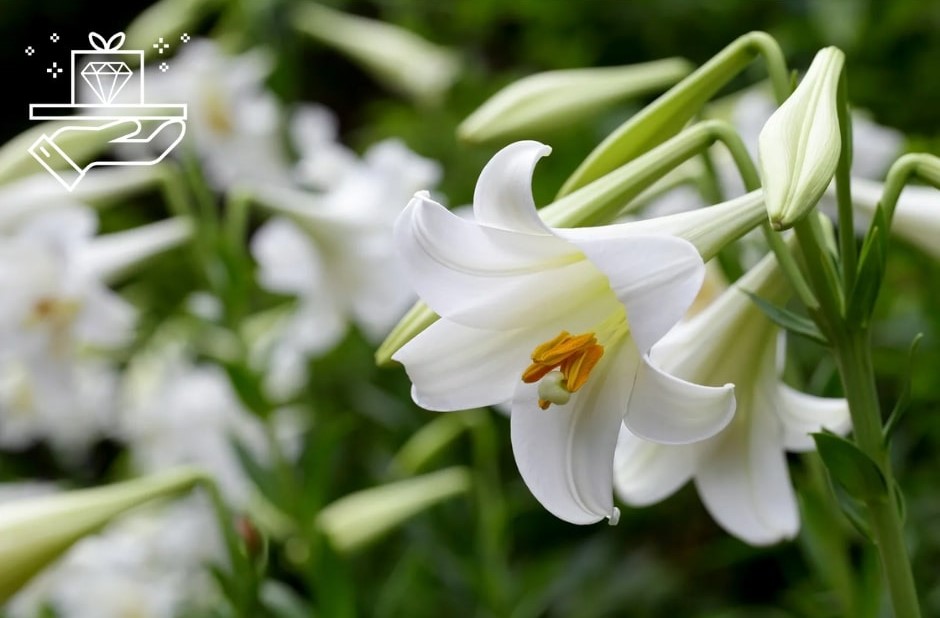The colorful petals of lily flowers whisper stories of love, admiration, and even mystery. This makes them a popular choice for bouquets and flower arrangements.
In this article, we will reveal the origin of lily flowers and the cultural contexts that have elevated their status. We will also discuss the meanings that come with their aesthetic and the ways they can be incorporated into our lives.
How did the lily flower get its name?


The name lily originates from the Latin word lilium, which references the beautiful and fragile nature of the flower.
What are the botanical origins of the lily flower?


Lilies belong to the Lilium genus, which encompasses around 80 to 100 species of lilies within the Liliaceae family.
These perennial plants are characterized by their scaly bulbs, slender stems, elongated leaves, and flowers that typically display six petal-like sections and can either be in clusters or as solitary blooms.
The majority of the native lily species come from Asia, Europe, and America.
Where do lily flowers grow?
Lily flowers thrive in a spectrum of environments, from sun-kissed open spaces to partially shaded woodland areas.
Their versatility allows them to bloom in gardens, flower beds, and even containers.
Do lily flowers require a lot of maintenance?
Contrary to their fancy appearance, lilies are actually low-maintenance flowers.
With proper care, they can make your living spaces look beautiful for a long time.
Regular watering, well-draining soil, and occasional fertilization are the secrets to keeping these floral wonders vibrant and enchanting.
Do lily flowers need shade or sun?
Lily flowers prefer abundant sunlight, but they also appreciate being shaded from the scorching midday sun.
Striking the right balance between sun and shade is essential to help them grow their best.
When do lily flowers bloom?
Lily flowers usually blossom the most during the fall and springtime.
They often start blooming in July and continue until August, although the specific timing can vary depending on the lily variety.
What kind of soil do lily flowers prefer?
Lily flowers prefer well-draining soil. This type of soil ensures that their bulbs don’t become waterlogged, which can lead to root rot.
Additionally, make sure that the soil they grow in is slightly acidic, with a pH level between 6 and 6.5.
What do lily flowers mean?
Every variety of lily has its own unique meaning. However, the most widespread symbolism of this flower is fertility and purity. It’s also associated with a fresh start at life and rebirth.
What do the colors and symbolisms of lily flowers mean?
White


The white lily stands for purity, the renewal of the soul, and rebirth. Interestingly, white lilies are also connected to sadness and remembrance during times of mourning.
Recommended Use: White lily flowers are a thoughtful gift for weddings, graduations, or other significant life transitions.
It can also be a symbol of sympathy when comforting someone who has lost a loved one.
Red


The red lily is all about romantic love and strong feelings. When combined with white lilies, they express a deep commitment, symbolizing true and lasting love.
Recommended Use: Red lily flowers are ideal for showing love on occasions like anniversaries, Valentine’s Day, or when you want to make a romantic gesture.
Pink


Pink lilies carry meanings of friendship, kindness, looking up to someone, and the qualities associated with being feminine. They’re also a sign of good fortune and having more than enough.
Recommended Use: Pink lily flowers are perfect charming gifts for birthdays, baby showers, Mother’s Day, or when you simply want to uplift someone’s spirits.
Yellow


Yellow lilies are linked to feeling thankful, joyful, loyal, and ready to start something new.
Recommended Use: Yellow lily flowers are great gifts for birthdays, housewarmings, or congratulatory events.
Orange


Orange lilies bring thoughts of wealth, hope, self-assuredness, and feeling joyful.
Recommended Use: Gift orange lilies to someone who is going on a new venture, such as a new job or a new home.
They’re also wonderful for occasions where you want to inspire confidence and positivity.
Purple


Purple lilies, though not as common, are still quite significant. They represent elegance, royalty, and pride.
They can also portray success and admiration.
Recommended Use: Purple lilies are excellent gifts for honoring achievements, whether academic, professional, or personal.
Green


Even though green lilies aren’t very common, they symbolize good luck. They are associated with growth and financial abundance.
Recommended Use: Green lily flowers are fitting presents for exams, job interviews, or opening a new business to express your wish for the recipient’s luck and growth.
What did lily flowers symbolize in various historical periods?


What are the cultural associations of lily flowers?


What are the spiritual or religious meanings of lily flowers?


What are the uses of lily flowers?


Beyond their beauty in bouquets and decor, lily flowers have found their way into various practical applications in cooking, medicine, and gardening.
How can lily flowers be used in cooking?


Each part of the lily plant, from its bulb to its leaves and petals, is edible. Here’s how each part can be used:
- Petals: The petals of lily flowers can serve as exquisite garnishes to summer salads with their vibrant colors or contribute a refined aesthetic to wedding cakes and appetizers.
- Bulbs: The bulbs and roots are the nutritious heart of true lilies. They can be incorporated into soups and stews, acting as natural thickeners.
Alternatively, you can stir-fry sliced lily bulbs and roots until they’re tender like fingerling potatoes.
- Flower Buds: Drying the buds of edible flowers like lilies can add distinctive touches to culinary creations. For example, Chinese chefs prepare dried, unopened tiger lily flowers known as golden needles or gum jum choi.
To dry your own buds and petals, place the lily flowers on a rock under direct sunlight for a few days.
Once the unopened flowers attain a crispy texture, they can be used to add texture to a foraged salad or incorporated into dishes alongside meat.
- Shoots and Leaves: Young shoots and leaves of lily plants can be alternatives to conventional herbs like basil and chives.
As with all edible flowers, the safety and intended use of lily flowers for consumption should be verified before incorporating them into your culinary explorations.
Can lily flowers be used for medicinal purposes?


Lily flowers have a history of being used for medicinal purposes to address an array of health concerns.
In native South American practices, the bulbs of lily flowers are dried to create a tea for their potent diuretic and laxative properties. They are also used to aid pregnant women during labor.
Also, lily flowers are used to treat fever and digestive tract issues and can be used to create an ointment to treat sores and burns.
How can lily flowers be used in gardening and landscaping?


Lilies come in a wide array of varieties, giving you numerous ideas to enhance your garden with landscaping. Here are some ways to do this:
- Mixing Different Lilies: You can make your garden interesting by planting different varieties of lilies together. Their colors and textures can create a nice focal point in your garden.
- Decorating Fences with Lilies: Lilies can also be put near fences to make them look nice and smell good. This is great for people who want a nice fence without spending a lot of time taking care of it.
- Lilies in Pots: Lilies can be grown in pots, and this can make your outdoor space look amazing.
They are also tough and can handle different temperatures.
Lilies in pots don’t need a lot of attention. Just water them regularly and remove old flowers if needed.
- Mixing Lilies with Other Plants: You can also mix lilies with other plants to make your garden look even better. Pairing lilies with grasses or other plants with colorful leaves can add depth and make your garden more interesting.




